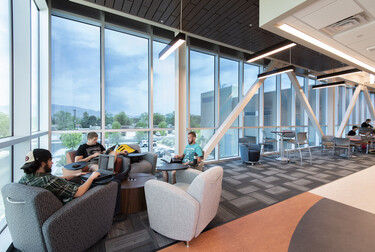Driving Enrollment with Smart Design

Higher education facilities are facing greater challenges than ever before. Nationally, a quarter of campus buildings are more than 50 years old, and stricter regulations and sustainability standards require facilities to modernize to meet advanced LEED certifications and net zero ambitions.
In response to aging infrastructure, maintenance backlogs are growing steadily, but the budgets needed to address building repairs have tightened. Even though tuition increased by 36% between 2008 and 2018, a decrease in foreign enrollment and the popularity of online education has driven a 1% decrease per year of enrollments over the last five years.
Faced with these serious challenges, how can colleges and universities stand out from competitors to better recruit students?
Innovation as a Recruitment Tool
In higher education, modern buildings can play a critical role in the recruitment of prospective students and their families. While sleek facilities with innovative technology can demonstrate a college's commitment to providing a best-in-class education, older buildings can communicate that an institution hasn't kept up with their competitors.
To address this challenge, higher education institutions around the world have turned to leading building technologies such as smart glass. Smart windows tint automatically in response to daylight to manage heat and glare, reducing the need for blinds and shades. This allows universities and colleges to meet their campus design goals by incorporating glass-centric buildings into their campus and boost wellness and learning by providing spaces with natural light and views.
In addition to its visual appeal and impact on the occupant experience, smart glass can also help campuses advance their sustainability goals by reducing energy consumption from HVAC systems. Dynamic glass can help universities achieve certifications such as LEED as well as support ambitions to achieve net zero or net positive.
College is a major investment and prospective students are seeking out the most innovative university that prioritize well-being and sustainability.